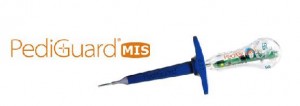 The spine, central to the nervous system and the very framework that enables movement and functioning, is a jack of all trades, a powerhouse for the entire body, but sometimes things go awry.
The spine, central to the nervous system and the very framework that enables movement and functioning, is a jack of all trades, a powerhouse for the entire body, but sometimes things go awry.
SpineGuard, the company behind the PediGuard technology platform contends that PediGuard is the first and only handheld, wireless device that can detect possible vertebral cortex perforation during pedicle preparation for screw placement.
Pedicle screw-based stabilization has become the gold standard for treating spine instabilities and deformities. This market is growing due to the increasing number of patients requiring surgical treatment and a larger number of surgeons being trained in pedicle screw-based technologies.
The pedicle screw, which is sometimes used as an adjunct to spinal fusion surgery, provides a means of gripping a spinal segment. The screws themselves do not fixate the spinal segment, but act as firm anchor points that can then be connected with a rod and prevents motion at the segments that are being fused to enable bone graft growth.
But, accuracy of pedicle screw placement is a critical issue in spine surgery:
• 10-40% of pedicle screws have been reported as misplaced.
• 2-10% of that number have resulted in pathological consequences.
With initial results of U.S. and European multi-centric clinical studies confirming its potential, the PediGuard® is emerging as the most compelling answer to this clinical need for safer pedicle screw placement.

PediGuard can alert the surgeon prior to a breach by accurately analyzing the electrical conductivity of the surrounding tissues in real-time. The use of PediGuard in minimally invasive procedures presents numerous benefits, such as reduced muscular trauma and blood loss, as well as decreased surgery time and postoperative pain. Consequently, length of hospitalization and recovery time are shorter, rehabilitation and/ or return to professional activity are faster.
SpineGuard recently announced the expansion of the Pediguard technology with the introduction of PediGuard Curve in an attempt to enable SpineGuard to further penetrate the spine surgery market, as about 30% of spine surgeons prefer a “curved”-tipped probe.
PediGuard Classic has been adopted by nearly 200 spine surgeons for more than 14,000 procedures across 30 countries. Now, PediGuard Curv expands the applicability of pedicle screw placement by allowing spine surgeons who prefer a curved-tip probe to benefit from the PediGuard technology value proposition while keeping the tactile feel with which they are familiar.
“We are very encouraged by the initial feedback on PediGuard Curv,” said Pierre Jérôme, CEO of SpineGuard. “This new product is strongly expected to be adopted quickly, especially in the U.S., where a large group of spine surgeons have learned to place pedicle screws via a curved-tip instrument. With the addition of PediGuard Curv, our PediGuard franchise is on its way to becoming a „must-have‟ solution to the well-documented clinical need for safer pedicle screw placement—the number one challenge in spine surgery.”
Co-founded in 2009 by Pierre Jérôme and Stéphane Bette, SpineGuard’s primary objective is to establish its FDA-cleared and CE Marked PediGuard® device as the global standard of care for safer pedicle screw placement in spine surgery.
Other companies making advancements in the field of spinal devices and orthopedics are LifeSpine, and Ortho Kinematics.